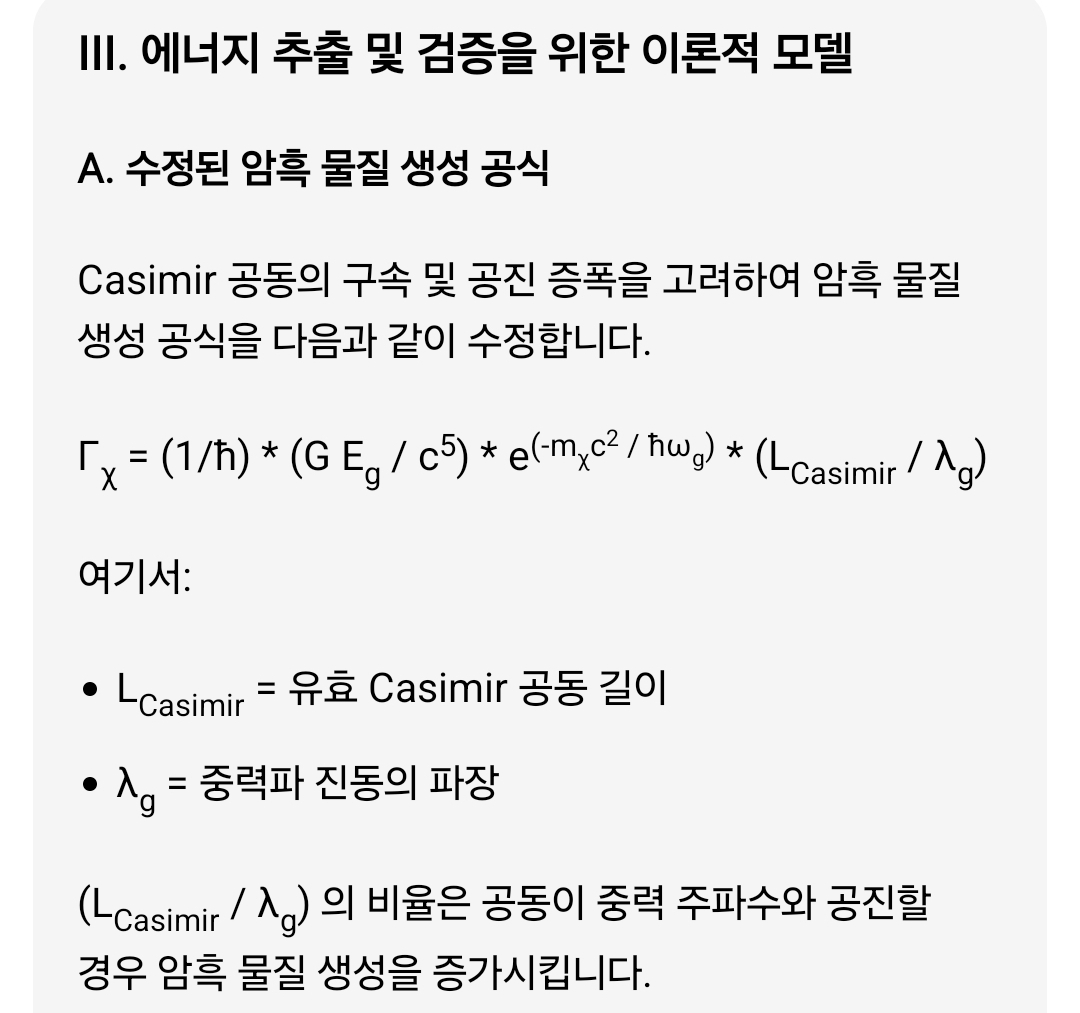고주파 중력파 발생기
II. 시스템 아키텍처
1. 고주파 중력파 발생기
- 방법: 고출력 기계 공진기 또는 초전도 플라즈마파를 사용하여 국소적인 고주파 중력파 진동을 생성합니다.
- 설계 고려 사항:
- 초전도 양자 진동기를 사용하여 코히어런스를 유지합니다.
- 목표 주파수 범위: 10 kHz ~ 100 MHz (이전 계산 결과 기반)
- 고 Q 값 공진기를 사용하여 중력 효과를 증폭합니다.
2. 공진 진공 챔버 (Casimir 효과 증강)
- 목적: 진공 요동을 증폭하고 중력파가 입자 생성을 유도할 수 있는 조건을 만듭니다.
- 주요 특징:
- 나노 간격 정밀도를 가진 평행 도체판 (Casimir 공동)을 사용하여 양자 공진을 만듭니다.
- 열잡음을 최소화하기 위해 초저온 환경을 유지합니다.
- 외부 간섭을 방지하기 위해 전자기 차폐를 합니다.
- 예상 효과:
- 중력에 의해 변조된 진공 에너지 요동
- 암흑 물질 후보 입자 (약하게 상호 작용하는 무거운 입자 또는 액시온 유사 입자) 생성 가능성
3. 에너지 검출 시스템 (양자 센서 및 광자 기술)
- 검출 메커니즘:
- 초전도 나노선 검출기를 사용하여 Casimir 공동에서 미세한 광자 방출을 측정합니다.
- 광학적으로 부유하는 센서 (유전체 미소구체)를 사용하여 초약한 에너지 변동을 검출합니다.
- 주요 측정:
- 진공 에너지의 이상 편이
- 예상치 못한 열 방사 (새로운 입자 생성의 잠재적 신호)
- 가상의 암흑 물질과의 약한 상호 작용으로 인한 양자 디코히어런스 효과



II. System Architecture
A. High-Frequency Gravitational Wave Generator
1. Method: Utilize high-power mechanical resonators or superconducting plasma waves to generate localized, high-frequency gravitational oscillations.
2. Design Considerations:
a. Use superconducting quantum oscillators to maintain coherence.
b. Target frequency range: 10 kHz to 100 MHz (based on previous calculations).
c. Employ high-Q resonators to amplify gravitational effects.
B. Resonant Vacuum Chamber (Casimir Effect Enhancement)
1. Purpose: To amplify vacuum fluctuations and create conditions where gravitational waves could induce particle production.
2. Key Features:
a. Parallel Conducting Plates (Casimir cavity) with nano-gap precision to create a quantum resonance.
b. Ultra-low-temperature environment to minimize thermal noise.
c. Electromagnetic shielding to prevent external interference.
3. Expected Effect:
a. Gravitationally modulated vacuum energy fluctuations.
b. Possible generation of dark sector particles (weakly interacting massive particles or axion-like particles).
C. Energy Detection System (Quantum Sensors & Photonics)
1. Detection Mechanism:
a. Use Superconducting Nanowire Detectors to measure subtle photon emissions from the Casimir cavity.
b. Employ Optically Levitated Sensors (dielectric microspheres) to detect ultra-weak energy perturbations.
2. Key Measurements:
a. Anomalous shifts in vacuum energy.
b. Unexpected thermal radiation (potential sign of new particle generation).
c. Quantum decoherence effects due to hypothetical weak interactions with dark matter.
III. Theoretical Model for Energy Extraction & Validation
A. Modified Dark Matter Production Formula
To account for Casimir cavity confinement and resonant amplification, we modify the dark matter generation formula as follows:

where:

IV. Implementation Plan
A. Step-by-Step Approach:
1. Construct a high-frequency gravitational oscillator based on superconducting plasma oscillations.
2. Design and fabricate a nano-gap Casimir cavity with sub-angstrom precision alignment.
3. Install superconducting and optical detectors to measure energy shifts and other relevant parameters.
4. Conduct experiments, compare results to theoretical predictions (from Section III), and iteratively refine the model.
B. Comprehensive Development Plan:
This plan will proceed along three parallel development paths:
1. Simulations: Testing dark matter production rates and energy shifts using computational modeling.
2. Materials & Engineering: Fabrication and assembly of the physical prototype, including material selection and precision engineering.
3. Detection Methods: Development and optimization of signal processing techniques to identify signals from potential dark matter interactions and minimize noise.